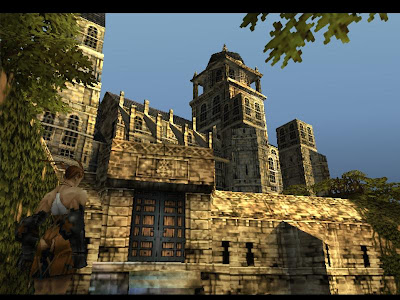Happy New Year!
5. Shin Megami Tensei: Nocturne (Atlus, 2004)
Megami Tensei is a long running series of games in Japan and Nocturne was the first North American release under the title. I came across this game completely by accident when my old roommate, who was a manager at EB, brought home new games almost weekly. The concept of Nocturne might be described as Pokémon in Pandemonium. You play as a high school student who accidentally interrupts a cult leader who is using the power of an ancient scripture to bring about “The Conception”— namely, the destruction and rebirth of Tokyo in his own image. In the progress, your character becomes a demi-fiend with the ability to recruit the various demons he meets while wandering around this occult-apocalyptic Tokyo, and looking for a “reason” to align himself with.
The biggest appeal of the game is undoubtedly in the demon summoning and fusion system, since the game is mad packed with all 150+ essential demonites to fortify your hex zone. That said the environment of Nocturne is an appropriately devilish combination of fascinating and infuriating. You spend most of the game exploring actual locations in Tokyo, and during my brief trip there in 2007, I visited most of the places that I’d become familiar with in the game — Shibuya, Asakusa, Ginza, Ikebukuro, and Shinjuku. I half-expected the statue of Hachiko outside Shibuya Station to morph into some kind of Cerberus and start mauling commuting salary-men…
The cell-shaded graphics and muted colours create a very surreal and otherworldly atmosphere in all the game’s locations. Admittedly, frustration kicks in when you find yourself lost and low on mp in the most tedious optional dungeon of all time— the Labyrinth of Amala.
While Kazuma Kaneko’s demon design is the obvious lynchpin of the game’s appeal, the demon infested Ex-Tokyo is a truly unique stomping ground.

Shibuya — teen hangout and demon mall.
4. Vagrant Story (Square, 2000)
Ivalice from FF Tactics, FFXII, and Vagrant Story was always one of my favourite of Square’s game worlds. While Vagrant Story is an incredibly awesome and challenging game, one of its biggest stars is the ruined city of Leá Monde. Designer Yasumi Matsuno modeled elements of Vagrant Story’s game environment off of Saint-Émilion, an ancient commune in the Aquitane region of France. The stonewalls, wine cellars, crypts and Romanesque churches are thrilling to explore, and the game’s sepia palate helps to create that weathered-parchment sense of high adventure.

Leá Monde in Vagrant Story.
3. Secret of Mana (Square, 1993)

If you had a friend handy, Secret of Mana was one of the most fun games on the SNES. The reason this is on the list is for a very specific section of the game, which I savor every time I play. Few things are as fun as running around in the Upper Lands forest through the pink trees of spring time, and wailing mercilessly on cute pink cottontails with a spear that “balloons” them. Seriously, I could do it for hours.
There’s something very appealing about the cute, pastel innocence of SOM. From the monster design to the mushroom land of Matango, it’s just fun. This is what makes the game stand out against the gravitas of games like FFVI (although there are cute bunnies to murder there as well…) the cheerful colours and soft edges of the monsters that you have to hack down in order to save the world. SOM is like an Easter basket where all the marshmallow peeps have battleaxes.

If you had a friend handy, Secret of Mana was one of the most fun games on the SNES. The reason this is on the list is for a very specific section of the game, which I savor every time I play. Few things are as fun as running around in the Upper Lands forest through the pink trees of spring time, and wailing mercilessly on cute pink cottontails with a spear that “balloons” them. Seriously, I could do it for hours.
There’s something very appealing about the cute, pastel innocence of SOM. From the monster design to the mushroom land of Matango, it’s just fun. This is what makes the game stand out against the gravitas of games like FFVI (although there are cute bunnies to murder there as well…) the cheerful colours and soft edges of the monsters that you have to hack down in order to save the world. SOM is like an Easter basket where all the marshmallow peeps have battleaxes.

Pleasure overload.
2. Chrono Cross (Square, 2000)Chrono Cross gave me the context for shades of blue I’d only ever seen written down— cerulean, azure. Last spring in Cuba with my girlfriend, I had to hold back from saying, “Wow! The water is just like Opassa Beach in Chrono Cross!” I’ve always found the lush archipelago of El Nido a great antidote for the winter blahs. To be honest, the game itself isn’t fantastic. In a massive cast of characters, only a handful of them stand out. The achingly beautiful musical score of Chrono Cross helps to define an otherworldly tropical paradise to explore, but the battle theme is extremely annoying. The game is full of contrasts, but the environment and the main themes are so beautiful that it stands on them alone.
While enduring a Nova Scotian winter, with grey mounds of antagonistic slush covering every street and sidewalk, sailing a skiff through a cerulean sea looks so many kinds of awesome.

Opassa Beach. Lay down your weary bones. Hopefully you won't fall into an alternate dimension...

Arni Village.

Divine Dragon Falls.
1. Wild ARMs (Media.Vision, 1997)
There’s something about that way that the original Wild ARMs perfectly blended conventional RPG fantasy with the sun-drenched mesas and red rock buttes of the Wild West. None of the five sequels were able to replicate that original concept without seeming the tiniest bit contrived— more Gunsmoke and less… je ne sais quoi.
The world of Filgaia brought to life the dusty trails of old westerns and filled them with golems, demons, and the titular “ancient relic machine(s).” This was a treasured game from my early teens, and although it is quite graphically dated, the concept art has left a lasting impression. The combination of Japanese and Western motif is a fairly natural one, considering Sergio Leone and Akira Kurosawa: the masterless ronin easily becomes the wandering gunslinger. Wild ARMs’ music as well is a natural element of the scenery, and like any good game, the environment is defined as much by the music as the images. Composed by Michiko Naruke in the style of Ennio Morricone, the music in Wild ARMs is among the best in any game. The opening theme is flat out one of the most beautiful pieces of music I’ve ever heard.
I still get a huge amount of pleasure from the earth tones and whistling that saturate this ancient savannah.
There’s something about that way that the original Wild ARMs perfectly blended conventional RPG fantasy with the sun-drenched mesas and red rock buttes of the Wild West. None of the five sequels were able to replicate that original concept without seeming the tiniest bit contrived— more Gunsmoke and less… je ne sais quoi.
The world of Filgaia brought to life the dusty trails of old westerns and filled them with golems, demons, and the titular “ancient relic machine(s).” This was a treasured game from my early teens, and although it is quite graphically dated, the concept art has left a lasting impression. The combination of Japanese and Western motif is a fairly natural one, considering Sergio Leone and Akira Kurosawa: the masterless ronin easily becomes the wandering gunslinger. Wild ARMs’ music as well is a natural element of the scenery, and like any good game, the environment is defined as much by the music as the images. Composed by Michiko Naruke in the style of Ennio Morricone, the music in Wild ARMs is among the best in any game. The opening theme is flat out one of the most beautiful pieces of music I’ve ever heard.
I still get a huge amount of pleasure from the earth tones and whistling that saturate this ancient savannah.




































